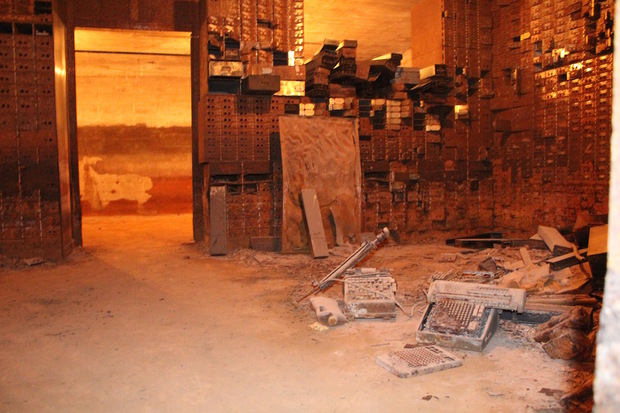GRAND CROSSING — The sounds of saws and drills filled a former Nation of Islam bank as crews worked furiously Friday to get Theaster Gates’ Stony Island Arts Bank ready for its first major event.
Gates and his Rebuild Foundation have spent the last two years converting the once-dilapidated bank into a 17,000-square-foot gallery and arts space at 6760 S. Stony Island Ave.
“One of the questions I ask myself is, ‘Who has the right to amazing culture, like the higher imagined possibilities of culture?’” Gates said at the bank Friday. “It has too often been relegated to the wealthy and elite, wherever they come from.”

Portuguese artist Carlos Bunga's cardboard art piece in the former lobby of the bank is the first major installation work for the Stony Island Arts Bank. [DNAinfo/Sam Cholke]
The bank opens to the public on Oct. 3 as a marriage of art world archives and a catalog of South Side culture.
Past the banks’ scarred columns are drawers of thousands of glass slides depicting nearly every major work of art from the Art Institute of Chicago and the University of Chicago’s archives. Just beyond rises a two-story library containing Johnson Publishing Company's entire editorial and research archive from Ebony, Jet and other publications. Turn a corner, and legendary Chicago house music DJ Frankie Knuckles’ entire record collection lines another wall.
The bank is Gates’ fifth and largest attempt to treat municipal code, housing policy and architectural forms as a kind of artistic medium that can be reconceptualized and at times reborn.
“Maybe all these things are reasonable forms that can be shifted like paint,” Gates said. “For me, this is shifting paint around.”
In flip-flops and a navy tunic, Gates looked down on the banks’ first major new work in the lobby, a massive two-story installation by Portuguese artist Carlos Bunga created for the weekend’s EXPO Chicago international arts exposition.
The art world would be the first to get to see the installation for a Saturday night dinner as part of EXPO Chicago, and crews were working just as hard to finish electrical work as they were erecting tents in the vacant lot on the north side.
The lot eventually will also become part of the bank, with a pavilion planned by Mexican architect Frida Escobedo for the Chicago Architecture Biennial using reclaimed bricks from the nearby St. Laurence Church, now demolished.
The bank originally was designed by William Gibbons Uffendell and built in 1923. It was only one among many grand buildings when Stony Island was a major commercial strip in the thriving middle-class black neighborhood.
It served turns as one of the neighborhood’s black-owned community savings and loan banks, ending its financial life under the direction of the Nation of Islam. It sat vacant for 30 years and was the last of the strip’s grand structures when Gates purchased the building for $1 in 2013.
After the arts world is done dining and drinking from the long antique bar Gates’ was gifted by a benefactor who hoped to hold her 80th birthday in the bank, the building will go dark for two weeks.
When it reopens to the public, it will mark a new era for Gates’ Rebuild Foundation.
“This is going to be our first project with regular operating hours,” said Ken Stewart, CEO of the Rebuild Foundation.
The bank will be open from 11 a.m. to 6 p.m. Tuesday through Saturday, something unheard of for a Gates project.
The Dorchester Projects, Black Cinema House and Kimbark Studios all operate on their own time. The doors are flung open when there is a film to be screened or an artist talk to host before closing again.
Gates said the bank will have steady arts programming, but that will largely be determined by how people in the neighborhood want the space to be used. He said he could imagine having a DJ-in-residence who really understood how Frankie Knuckles record collection should be rethought and heard — and that’s not through headphones.
“That would be a horrible way to listen to house music,” Gates said. “I want to feel the music in my body. I want it to chip the paint in the building and help it settle — maybe I don’t really mean that.”
The basement and its massive rusting vault, which was under 5 feet of water when Gates purchased the building, is gallery space now, but is envisioned as a performance space if that’s the need.

Gates said some of the programming that was happening at his other projects would move to the bank, allowing Dorchester Projects to return to its roots as the secret garden of the Chicago art world.
“Those houses can function again as secret little gems where anything can happen,” Gates said. “I hope Dorchester will have that enchanted feeling again.”
The bank opens Oct. 3 as one of only six official venues for the Chicago Architectural Biennial.

The Stony Island Arts Bank opens to the art world on Saturday for a special gala and opens to the public on Oct. 3.

The entire editorial and research library of Johnson Publishing takes up two stories of library space.
For more neighborhood news, listen to DNAinfo Radio here:




















